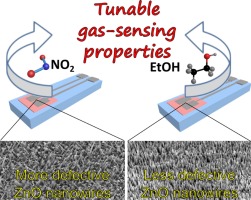ZnO nanowires (NWs) oriented in three different directions were synthesized via the vapour-liquid-solid technique over c-, r- and a-plane sapphire substrates. Gas sensing properties of these samples against reducing and oxidizing gases were examined. ZnO NWs grown on the c-plane substrate showed the highest response to oxidizing gases (NO2), while those grown on the a-plane substrate were more responsive to reducing one (ethanol). According to the insights gained by photoluminescence studies, the distinct responses were clearly correlated with the quantity and type of defects present in the material, and ultimately, relating the orientation of the different ZnO NWs sensors to their gas sensing characteristics, showing a possible rational strategy to tailor oxide nanomaterials for gas sensing applications.
